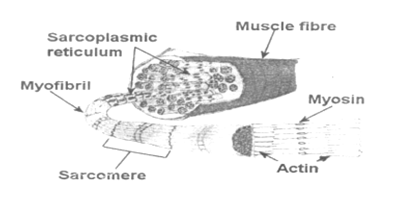Where are hinge joints found in human body?
Hinge joints are found in the elbow joints, knee joints and phalanges in finger in the human body.
Explain structure of the muscle with the help of a diagram.
There are about 600 voluntary muscles in the body. Each muscle is made up of thousands of long and narrow muscle cells called muscle fibers. These muscle fibers are arranged in bundles and enclosed within a tough layer of connective tissue called epimysium (sarcolemma). Every muscle fiber is made up of very large number of microscopic threads called myofibril. Myofibril consists of protein molecules called actin and myosin.

Explain external and internal respiration.
Inhalation and exhalation are the two processes of external respiration. This breathing process oxygenates to the blood. It gets purified as carbon dioxide is removed from the blood. External respiration takes place in the lungs. Internal respiration is the process of respiration that takes place in the tissues and cells. Blood full of oxygen reaches the tissue where oxygen is used up during the energy production process and carbon dioxide is then taken by the blood to the lungs.
What are the functions of respiratory system?
The main functions of respiratory system are given as under:
Define the phenomenon of second wind. What are its causes and symptoms?
The breathlessness caused due to prolonged exercise is removed automatically by our body within short span of time of such exercise. This sense of relief is called 'second wind'.
Causes of second wind: When we perform strenuous exercise, our body takes some time to adjust according to the increased demand of energy. So, the second wind occurs before the adjustment.
Symptoms of second wind:
